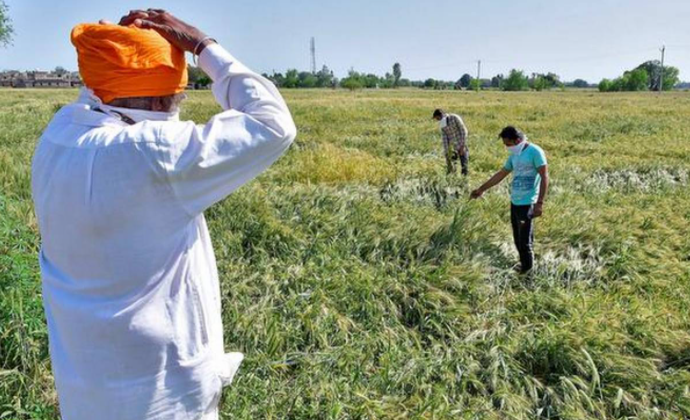Despite increased sowing areas, the groundnut production in Gujarat would hardly exceed last year’s output, Kishor Viradia, president of Saurashtra Oil Mills Association (SOMA), said.
By Prabhudatta Mishra & Nayan Dave
Large-scale crop damages in about half a dozen states, due to recent unseasonal showers caused by deep depression in the Bay of Bengal, are causing serious concern. Anecdotal data and information gathered by FE from traders and farmers indicate harvest-ready crops such as cotton, groundnut, moong, tur, maize and even paddy have suffered serious damages due to the unexpected heavy rains amid the monsoon’s withdrawal in Andhra Pradesh, Telangana, Maharashtra, Gujarat and Karnataka.
Also Read: Rupee Slips 32 Paise To 73.89 Against US Dollar
Preliminary estimates suggest that standing crops on up to 30 lakh hectares have suffered destruction, denting the chances of good returns for the farmers.
In some mandis like Gujarat’s Rajkot, the arhtiyas (commission agents who serve as link between farmers and buyers) are either refusing to lift the crops from farmers or are offering prices that are far below minimum support prices (MSPs). They cite poor quality of crops due to high moisture content. This also explodes the myth that the mandi system, for all its limitations, is last resort to farmers in distress, thanks to a symbiotic, long-established relationship between arhtiyas and farmers.
Those who saved crops from submergence in earlier spell, are still waiting for sunshine to dry those crops before they could start harvesting as the crops are not getting sold or commanding very low prices at mandis.
Gujarat, the top producer state of groundnut, is witnessing poignant scenes of huge piles of oilseed crops languishing at the mandis in the open, as desperate farmers seek to sell the crop as early as possible and earn something before the Navaratra festival.
As per government norms, groundnut having more than 8% moisture would be rejected for buying at MSP. “So, even as the official procurement started from Wednesday, we sold the initial crop in mandis at slightly lower prices than MSP due to moisture,” said Jilesh Kalaria, a farmer of Rajkot. Good- quality groundnut, however, is still being sold at Rajkot mandi at about Rs 5,500/quintal, which is more than its MSP value (Rs 5,275/quintal), said Atul Kamani, a leading trader of groundnut and cotton.
Traders said that due to extended and excessive rains there might be around 30% damage to groundnut crop and the state’s output of the oilseed might end up in the range of 35-38 lakh tone, down from the government’s first estimate of 55 lakh tonne.
Initial reports also suggest standing crops like soyabean, bajra, cotton and onion on over 9 lakh hectares have been affected in Maharashtra with Solapur, Pune, Satara and Osmanabad among the worst-hit districts. The state has reported this year’s kharif acreage at 145 lakh hectare (except sugarcane) as of October 12. In Karnataka, crops spread over 10 lakh hectare in 23 districts have been affected with sunflower, ragi and moong crops having been washed away at some places.
Though the Telangana government is yet to release an official estimate of the extent of crop damage, farmer leaders say about several lakh acres have been affected, with cotton, paddy and maize among the worst hit. Over 1 lakh hectare of agriculture and horticulture in Andhra Pradesh too has been affected.
As reported by FE earlier, PAN-India mandi prices of seven among the 10 key summer-sown crops are currently ruling below their MSPs. Farmers sold seven kharif crops including jowar, bajra, maize, moong and soyabean at prices 8-38% below their MSPs during October 1-15. Only arhar and urad were costlier to wholesalers than their MSPs during the period, while the rate for paddy was closer to the MSP.
Despite increased sowing areas, the groundnut production in Gujarat would hardly exceed last year’s output, Kishor Viradia, president of Saurashtra Oil Mills Association (SOMA), said. The area expanded by more than 25% to 20.7 lakh hectare after many farmers shifted from cotton to groundnut in 2020.
Paddy fields have also been damaged due to recent floods in Telangana and Andhra Pradesh. Ganta Shankar, a farmer in a village near Warangal, says though he had spent Rs 3 lakh for the cultivation, with 70% crops damaged, even a third of his cost won’t be recovered. The Fasal Bima Yojana is not being implemented in the state, meaning he can’t even make insurance claims to stem the losses.
Similar is the tale of Tukaram Naik, a farner in Maharashtra whose cotton bales have been rejected by the Cotton Corporation of India due to higher moisture content.
The India Meteorological Department has predicted another deep Depression over the Bay of Bengal as a result heavy to very heavy rainfall is expected in West Bengal from October 23. It has issued warning against possible damage to horticulture and standing crops in some areas due to ‘inundation and squally winds’.
On its part, the Centre expects for the fifth consecutive year the country will have record kharif production of food grains of 144.5 million tonne. “But does record production ensure good income for farmers?” asks Sanjeev Seth, a researcher in agriculture prices.


